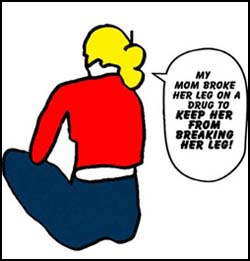 Bisphosphonates, to prevent postmenopausal osteoporosis, have been linked to jawbone death (osteonecrosis) and atypical fractures. Recently, Dr. William Banks Hinshaw, a gynecologist and chemist in North Carolina, likened their actions to an affliction seen 100 years ago.
Bisphosphonates, to prevent postmenopausal osteoporosis, have been linked to jawbone death (osteonecrosis) and atypical fractures. Recently, Dr. William Banks Hinshaw, a gynecologist and chemist in North Carolina, likened their actions to an affliction seen 100 years ago.
Rosenberg: You recently co-authored two scientific papers about the biochemical actions of bisphosphonate bone drugs such as Fosamax, Boniva, and Actonel, and Reclast. In one paper [in the January issue of ACS Medicinal Chemistry Letters] you and your co-author suggest the same negative bone effects now emerging with the drugs date back to a disorder seen during the industrial revolution. In the other [in December's Journal of Clinical Endocrinology & Metabolism] you and your co-authors examined 81 patients who experienced fractures, sometimes four or five, on the drugs.
Hinshaw: 150 years ago, people who worked around white phosphorus in factories where matches were made in the US and Europe sometimes developed “phossy jaw” (osteonecrosis) and thigh bone fragility similar to bisphosphonate effects we see today. The chemical culprit is likely to have been a substance in the white phosphorus smoke that inhibits an enzyme involved in the process of bone remodeling and bisphosphonates happen to have been innocently developed as synthetic versions of that substance. I have researched this extensively, including US Army reports about white phosphorus smoke which was shown to include large amounts of the same substance.
Rosenberg: Why would drugs with such an undesirable safety profile be so popular?
Hinshaw: The bisphosphonates are a very polarizing class of drugs. The enthusiastic industrial support of the clinical trials has created a cadre of dedicated bisphosphonate supporters, convinced that the presumed benefits outweigh any possible risk. Despite a trend toward less use (for which I credit the good sense of the patients), Fosamax in its cheap generic form [alendronate] is still the most prescribed drug for postmenopausal treatment or prevention of osteoporosis. Because of its attractive price, it is still the first choice of the insurance companies who pay for the drugs, and there is no evidence that this is going to change any time soon.
Rosenberg: Clinical trials of bisphosphonates has been impeded by the difficulty in finding women who don’t have the drug in their system. How long do the drugs remain in the body?
Hinshaw: Bisphosphonates are nonmetabolizable, resident drugs that never completely leave the body—never. After treatment stops, the burden decreases but there is no point when the resident molecules can be expected to be completely gone. They are not found in circulating serum (except temporarily with an injectable bisphosphonate like Reclast) because they attach so rapidly to calcium/bone. When they happen to be released from one cache, they can be “recycled” into others. They have such a strong attachment to calcium that patients who swallow calcium supplements when they take bisphosphonates, against directions I may add, may be doing themselves a favor—because bisphosphonates will bind to the calcium instead of their bone.
Rosenberg: There have been media reports, particularly National Public Radio, of the bone density craze and the term “osteopenia”—the risk of thinning bones—as being concocted by the drug industry to sell drugs.
Hinshaw: The risk of fracture from fragile bones exists for some individuals, but I think the selling of bisphosphonates is a prime example of disease mongering. My wife, with whom I share a gynecological practice for women of menopause age, and I have not prescribed them since 1998 when it became apparent to us that their action does not make sense metabolically or chemically. They suppress bone remodeling as if bone remodeling were the “bad guy” in osteoporosis and doesn’t have the purpose of renewing and strengthening bone. They create a temporary improvement in the balance between bone loss and bone formation which are normally linked—but in a short time bone formation is suppressed, too.
Martha Rosenberg is a health reporter whose food and drug expose, Born with a Junk Food Deficiency (Prometheus Books, 2012), was named in the American Society of Journalists and Authors 2013 Outstanding Book Awards. A former medical copywriter and medical school lecturer, Rosenberg has appeared on CSPAN, National Public Radio, the Ed Schultz show and RTV. “Born” has been praised by Library Journal, the Public Library of Science and cited by the Sloan-Kettering library. Rosenberg spoke at the Mid-Manhattan Public Library in June.


